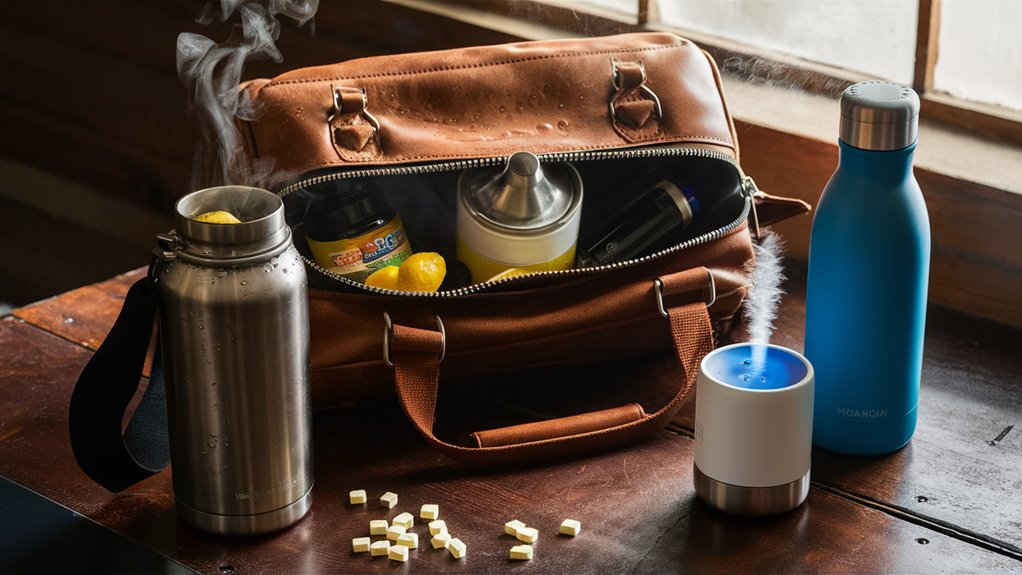
How to Prepare Your Voice for a Night of Karaoke
Essential Steps to Prepare Your Voice
If you want your voice in peak form when the time comes to hit the stage then proper hydration is essential. Start drinking 8-10 glasses of room temperature water 24 hours before your karaoke session so that your vocal cords stay lubricated and you sound clear throughout the night.
Vocal Warm-up Techniques
- Perform steady humming exercises.
- Practice lip trills and tongue rolls.
- Execute ascending and descending vowel scales.
- Do some breathing exercises concentrating on diaphragmatic control.
Pre-Performance Diet Guidelines
Avoid the following vocal hazards:
Dairy products which contribute to mucus production.
Caffeinated drinks, leading toward drying out in the throat.
Acidic foods are detrimental to optimal vocal cord function.
Alcoholic beverages and carbonated soda interfere with cleanliness and vocal control.
Soul Life Conservation: Apply Rest and Rejuvenation to Your Voice
Relax the voice box 2-3 hours prior to hitting the stage on which you will speak or sing. One method is by typing messages for this period. Another way to achieve silence before hitting the stage can be through silent breathing exercises; these should help get ready without a word uttered! The same goes for throat-clearing and excessive coughing. Try practicing correct posture to better support large breaths.
Performance Preparation Essentials
Now, assemble your karaoke survival kit including:
Throat lozenges in case of hoarse throat or coughs during singing, and natural honey for grabbing whilst pausing time… These items can often be found at the bar if you’re singing in a nightclub.
Finally, take along lyrics for everything you are going to sing if possible as well as sheet music in situations when this is permitted by whoever controls the sound equipment at your gig.
Pick songs which suit your own vocal range to avoid strain.
Put the microphone close to your mouth and stay within your natural range for maximum voice projection and preservation.
Stay Hydrated for the Day in This Way
More Practical Information And Practical Tips for Vocalists – Stay Supercarefully Hydrated
Understand the Vocal Hydration Basics
Healthy, flexible vocal cords depend upon proper hydration. The idea is that fluid temperatures will match the vocal cords’ temperatures for optimum consistency in tone and volume all day long while endless absorption opportunities from liquid–good ones at least–abound. In this way, we are always ready performance-wise.
Suffice to say, then, ‘room temperature’ is the key here. Now let us look at how best to do it…
It is most important to keep the throat moistened yet not so cold as to cause discomfort (which would make it harder for one’s voice). The best solution in this case is room temperature water.
Strategic Hydration Timeline
Throughout the day, use these checkpoints for hydration:
Morning routine: Two glasses as soon as you wake.
Times to Drink:
One glass between every meal.
Preparing for the night: One glass two hours before going to bed.
Avoiding Vocal Dehydration
Dehydrating substances which have indirect impacts on vocal quality are to be avoided:
Caffeine and alcohol are diuretics.
If you drink coffee, follow with two glasses of water.
Take a close look at your fluid intake in the last tune-up hours before a performance.
Pre-Performance Hydration Protocol
During the final phase of pre-performance preparation:
Keep your water bottle handy.
Take a few sips of water every 15-20 minutes.
Allow time for tissue absorption after drinking it.
A sustained effort to remain well hydrated rather than waiting until the last moment to take in liquid.
This systematic approach to vocal hydration keeps the mucous membrane that surrounds the vocal cords moist at optimal levels, which is essential for maximum performance potential.
Warm Up Your Vocal Cords
The Vocal Warm-Up Guide: Key Techniques for Peak Performance
Fundamental Warm-Up Moves
Start your vocal warm-up routine with gentle hums for 2-3 minutes.
Gradually transition from the low notes to the high ones within your comfortable range activating your resonators and preparing your vocal cords safely all at once.
This basic technique establishes correct vocal placement and reduces the risk of strain.
Advanced Resonance Techniques
Add lip trills and tongue rolls to your practice by creating motorboat sounds while keeping your vocal range firmly in mind all the time.
You can also perform sustained vibration exercises with long “vvv” or “zzz” sounds as an alternative to these methods.
Carry out these exercises for 3-4 minutes each time until you can feel your facial muscles contracting.
Vowel Control Development
“mee-may-mah-moh-moo” sequence exercises are to be mastered along with their requisite pitch levels.
Once you’ve got that down, jump an octave with “o” and “a” to practice note discrimination.
Spend five minutes on each of these key exercises, getting the pitch and note transitions down ritualistically correct.
Consonant Articulation Exercises
Through carefully pre-formulated and targeted sentences like “tip-top” and “kick-quick,” you can improve your delivery of consonants.
Articulation exercises like this develop lyric clarity and precise pronunciation which are the basic tools of a singer’s trade.
Focus on getting the consonants as crisp and clear as possible to maximize the vocal impact.
Singing Fruits and Juices Improve the Immune System and Health
Chocolate, Peanut butter, dairy Foods to Avoid:
Dairy products should be completely avoided approximately 4 to 6 hours before singing performances: the excessive mucus on your passages that they generate will reduce vocal clarity and projection.
Chocolate is a tough one. If you notice any discomfort or irritation after eating certain foods, consult an ear, nose, and throat specialist for more information.
Due to their caffeine and dairy content, chocolate and its ilk pose two threats to the vocalist: thus they should be completely avoided before concerts.
Although the singer’s diet should always be nutritional, and oiled salads are out.
Singing and Eating Gooseberries: These products can encourage acid reflux, which logically should be avoided as well.
Spices Doused in Many Irradish Acts: Spicy foods also have such risks, producing inflammation in the throat and rendering a singer unable to concentrate at all. Such irritants will seriously harm both the quality and tone of your singing performance.
Be sure and drink plenty of water; the container should have a wide diameter.
Cold Water: Because both these substances will dehydrate and damage your vocal cords, caffeine as well as alcohol are especially harmful to singing vocal cord injuries.
Thus its dehydrating effect can last up to four hours so do not drink coffee before a singing engagement or on the eve of one!
Tea in the evening: Wines, some people get What to Expect From a VIP Karaoke Experience heartburn from eating specific types of spicy food.
All types: Apple cider vinegar.
There should be at least a two-hour wait between eating and singing in order to ensure excellent digestion / clear singing.
Rest Your Voice
Vocal Rest Techniques for Superior Singers
When to Take a Rest Period Without Overtraining Your Voice
Voice rest is very important to optimum vocal preparation before your session.
In this crucial rest period, you must eliminate all unnecessary vocal activities such as singing or speaking about disquiet for help.
Now you should use alternate means beit text messaging or handwritten notes during this period of vocal rest.
In fact, soft speaking is the best.
Proper breathing techniques should be incorporated as part of this meditation in order to reinforce your learning.
Singing Energy Preservation
However, many people warm up with too many sounds that tire the voice before they even get started.
Instead, save energy by not making any excess noise.
Look after your voice just like an athlete takes care of their muscles – ample relaxation brings great results during periods of rest leading into an intense competition.
Pay attention to your exercise, light neck stretches, breathing out slowly without sound as well as keeping your shoulders taut. This serves to prepare your vocal cords optimally in advance of performance time.
Exercises for Breathing
Vocal Performance Breathing Drills We Must Do
This is really the root of good singing skill.
Put your right hand on your chest and your left hand on your belly. When you inhale, really try to expand your stomach but keep your chest fairly motionless. Send six seconds worth of exhalation sound out each time as well.
Take 5-10 minutes to do these fundamental exercises before moving onto more complex drills.
Advanced Breathing Techniques
The Move-and-Count Method, An Indispensable Training Aid for Your Breathing.
Confront any phrase louder but it’s only third as far away.
Take ten short intervals and steadily extend them one by one until you are able to catch the rising breath at the very top of each note with your throat thrilling stairs.

Practice Breathing Application
The hiss exercise gives us a good chance to develop greater control over our breathing during performances.
In the current case, let us draw a deep, steady breath and exhale it with controlled hissing sounds which come from our mouth.
Record how long you can last and aim for a higher level with each passing attempt. This exercise serves to directly improve the sustainability of vocals during singing performances.
Snap Breathing Method
The quick-sip technique is very useful for quick recovery of the breath while you sing up-tempo songs.
Therefore, you need to keep practicing (between phrases) all through a longer song without pausing.
During quick changes in pace, this is of particular importance.
Find Songs That Suit Your Vocal Range
How to Choose Songs Within Your Vocal Range for Karaoke Success
Understanding Your Vocal Range
A successful karaoke performance can only be ensured once it is established what vocal range you are in.
You’ll need to start with the basics: finding out what voice category you are. Some people have high voices. Some people have low voices. Some people have limited ranges. Other people have ranges that are very wide indeed.
Please sit down at a piano or tuner with proper keys and range of pitch to determine your singing capacity: those notes that are relatively comfortable for you; clear articulation in terms of pronunciation. This will help determine what kind of music you might choose to sing. With some sense as well as sensitivity, we recommend that this does not take place before bedtime. Everyone has a certain range: what are your lows and highs? https://getwakefield.com/
What Is Your Voice Type?
It may be helpful to record yourself doing songs of differing styles to see where your voice is naturally at its best.
Your task is to create a song book that best matches the range of your voice.
Most of the newer karaoke apps are equipped with tech that will raise the pitch of songs, so it’s not hard to adjust a song into your range.
Selecting Appropriate Songs
Middle Range Focus
Vocal variation is where vocal variations begin.
A good rule of thumb is to begin with songs that lie in the middle of your vocal range where you will be most comfortable. This will help you gain confidence and maintain a more consistent voice.
Then select song styles that:
Match your established vocal range.
Highlight your natural tonal qualities.
Do not require difficult new techniques that are beyond your skill.
Technical Considerations
To pick a potential song out you need to be wise. Watch for these traps:
Repeated high notes that may cause tension.
Vocal runs with high levels of technique involved.
Sustained exposure in the vocal extremes.
Song Adaptation Strategies
Using digital rendering tools to change the chord for optimal singing is now a good idea.
The key lies in choosing music that naturally caters to your strengths rather than being dragged off by popular trends.
This kind of focused approach is to ensure more interesting, more confident performances.
Karaoke XC Essential Supplies List
Vocal Care Kit
Your throat lozenge, bottle of water, and lip balm are the essential items that make up your karaoke survival kit.
These are the remedies for keeping your voice fresh and alive through a session of singing, throat-coating tea bags and small packets of honey should be with you always.
Performance Support Items
Throat spray, together with throat coat tablets, will give you instant relief between performances.
When you’re getting ready to belt out a tune, it’s always a good idea to sprinkle a few breath mints in your mouth and chew some gum on top.
Have a performance notebook with lyrics for backup in case you forget.
Health and Clean-up Supplies
Microphone caps or sterilizing wipes can help to maintain proper hygiene standards when singing in public.
Bring a performance towel to mop off sweaty hands under the bright lights on stage.
If you have been ordered medications or antihistamines against possible vocal problems due to allergies or environment-related factors.
Additional Stage Equipment
Extra batteries for wireless microphones.
Back-up power supply for digital song lists.
Small rubber flashlight in case of low-lighting situations.
Healthy Voice Drops if the singing session is to be a lengthy one.
Performance clothing accompaniments.






